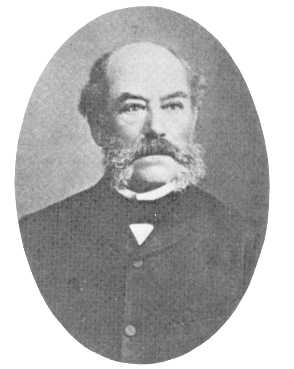Adrian
G. Iselin, Chief Investor of the
Rochester and Pittsburgh Coal and Iron
Company
 Adrian
G. Iselin was a New York investment banker and chief investor in the Rochester
and Pittsburgh Coal and Iron Company. He was born in 1818 and died in 1905 leaving
the management of his investments and companies to two of his sons, Adrian Jr.
and Columbus. Adrian Jr. who was born in 1846 and died in 1925 was responsible
for the expansion of the Company into Indiana County, Pennsylvania. Ernest Iselin,
son of Adrian Jr., was director of the company from 1929 to 1934 and chairman
of the board from 1936 to 1954. According to his March 29,1905 New York Times
obituary, Adrian G. Iselin's wealth was estimated to be between 20 and 30 million dollars.
Adrian
G. Iselin was a New York investment banker and chief investor in the Rochester
and Pittsburgh Coal and Iron Company. He was born in 1818 and died in 1905 leaving
the management of his investments and companies to two of his sons, Adrian Jr.
and Columbus. Adrian Jr. who was born in 1846 and died in 1925 was responsible
for the expansion of the Company into Indiana County, Pennsylvania. Ernest Iselin,
son of Adrian Jr., was director of the company from 1929 to 1934 and chairman
of the board from 1936 to 1954. According to his March 29,1905 New York Times
obituary, Adrian G. Iselin's wealth was estimated to be between 20 and 30 million dollars.
Before his involvement with coal in Pennsylvania,
Iselin was one of the directors of the Sioux City and St. Paul Railroad Company
in Minnesota. The town of Adrian, Minnesota, which developed after completion
of the rail lines, was named after Mrs. Adrian Iselin, mother of Adrian G. Iselin.
Her portraits hangs in the Adrian City Hall. Through the efforts of a bishop
who used the influence and power of the Catholic press, eastern Catholics were
encouraged to settle in Adrian and the surrounding areas. Although Iselin
himself was not a Catholic, his wife and his family were members of the faith.
In addition to his numerous business investments,
Iselin was also a philanthropist. He and his family were responsible for the
building of two Catholic churches in New Rochelle, New York, and a number of
Catholic churches in his Coal Company towns including St. Adrian's in Adrian,
Pennsylvania. He and his family were also responsible for the building of several
hospitals, including the Adrian Hospital in Puxnsutawny, and the Indiana Hospital
in Indiana, Pennsylvania. In New York City Iselin was a stockholder in the Metropolitan
Opera and Real Estate Company, along with other wealthy men that included Cornelius
Vanderbilt and J.P. Morgan. Iselin was one of the incorporators of the
Museum of Natural History and the Society for the Prevention of Cruelty to Animals.
Like many rich men of his day, he had a portrait of his wife, Eleanor,
painted by the famous American artist John Singer Sargent.
In 1902, 40,000 acres were purchased in Indiana
County under the Iselin name. They were parceled out to four of his companies: Consolidated Coal and Iron
Company, Indiana Coal Company, Rochester and Pittsburgh Coal and Iron Company, and the Jefferson and
Clearfield Coal and Iron Company. This measure was due to a recently enacted state
law stipulating that any one coal company could not control more than 10,000
acres.
The coal-mining town of Iselin, one of the many
company towns in Indiana county founded by the Rochester and Pittsburgh Coal
and Iron Company, was named after him. The Iselin family also controlled the Buffalo, Rochester and Pittsburgh Railway
Company, which transported coal from Pennsylvania to markets along the Great
Lakes and Canada.
Photo
courtesy: Eileen Mountjoy Cooper, The Rochester and Pittsburgh Coal Company:
The First One Hundred Years (Indiana, Pennsylvania: Rochester and Pittsburgh
Coal Company, 1982), 23.
New York Times, 29 March 1905.
Clarence
D. Stephenson, Indiana County, 175th Anniversary History,
vols. 2,4
(Indiana, Pennsylvania: Halldin Publishing, Company, 1989, 1983), 191, 575-577.
Adrian Local History. 2002. <http://www.adrianmn.net/history/localhis.htm>
(25 November 2001).
Metropolitan
Opera History: From the Metropolitan Opera Archives. n.d. <http://www.metopera.org/history/week-991115.html>
(25 November 2001).
National Gallery of Art. John Singer
Sargent. 2002. <http://www.nga.gov/collection/gallery/gg69/gg69-49935.0-prov.html>
(19 November 2001).
 Adrian
G. Iselin was a New York investment banker and chief investor in the Rochester
and Pittsburgh Coal and Iron Company. He was born in 1818 and died in 1905 leaving
the management of his investments and companies to two of his sons, Adrian Jr.
and Columbus. Adrian Jr. who was born in 1846 and died in 1925 was responsible
for the expansion of the Company into Indiana County, Pennsylvania. Ernest Iselin,
son of Adrian Jr., was director of the company from 1929 to 1934 and chairman
of the board from 1936 to 1954. According to his March 29,1905 New York Times
obituary, Adrian G. Iselin's wealth was estimated to be between 20 and 30 million dollars.
Adrian
G. Iselin was a New York investment banker and chief investor in the Rochester
and Pittsburgh Coal and Iron Company. He was born in 1818 and died in 1905 leaving
the management of his investments and companies to two of his sons, Adrian Jr.
and Columbus. Adrian Jr. who was born in 1846 and died in 1925 was responsible
for the expansion of the Company into Indiana County, Pennsylvania. Ernest Iselin,
son of Adrian Jr., was director of the company from 1929 to 1934 and chairman
of the board from 1936 to 1954. According to his March 29,1905 New York Times
obituary, Adrian G. Iselin's wealth was estimated to be between 20 and 30 million dollars.